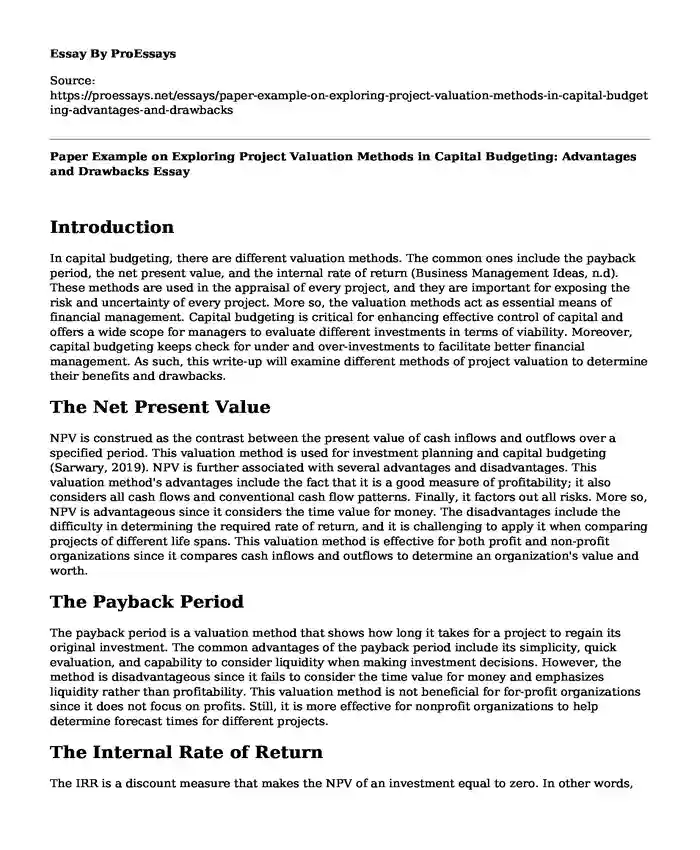Introduction
In capital budgeting, there are different valuation methods. The common ones include the payback period, the net present value, and the internal rate of return (Business Management Ideas, n.d). These methods are used in the appraisal of every project, and they are important for exposing the risk and uncertainty of every project. More so, the valuation methods act as essential means of financial management. Capital budgeting is critical for enhancing effective control of capital and offers a wide scope for managers to evaluate different investments in terms of viability. Moreover, capital budgeting keeps check for under and over-investments to facilitate better financial management. As such, this write-up will examine different methods of project valuation to determine their benefits and drawbacks.
The Net Present Value
NPV is construed as the contrast between the present value of cash inflows and outflows over a specified period. This valuation method is used for investment planning and capital budgeting (Sarwary, 2019). NPV is further associated with several advantages and disadvantages. This valuation method's advantages include the fact that it is a good measure of profitability; it also considers all cash flows and conventional cash flow patterns. Finally, it factors out all risks. More so, NPV is advantageous since it considers the time value for money. The disadvantages include the difficulty in determining the required rate of return, and it is challenging to apply it when comparing projects of different life spans. This valuation method is effective for both profit and non-profit organizations since it compares cash inflows and outflows to determine an organization's value and worth.
The Payback Period
The payback period is a valuation method that shows how long it takes for a project to regain its original investment. The common advantages of the payback period include its simplicity, quick evaluation, and capability to consider liquidity when making investment decisions. However, the method is disadvantageous since it fails to consider the time value for money and emphasizes liquidity rather than profitability. This valuation method is not beneficial for for-profit organizations since it does not focus on profits. Still, it is more effective for nonprofit organizations to help determine forecast times for different projects.
The Internal Rate of Return
The IRR is a discount measure that makes the NPV of an investment equal to zero. In other words, the IRR is the measure of a project’s expected future rate of return. This valuation method examines if a project has made or lost money (Al-Mutairi, Naser, & Saeid, 2018). Some of the common advantages of these methods include its simplicity and ability to consider the time value for money. However, it is disadvantageous since it ignores the economies of scale, and it has the implicit assumption of the reinvestment rate. This method is mainly effective in for-profit organizations since it determines what has been lost or made.
Each method of valuation discussed above is beneficial in its aspect. For instance, the payback period shows the time taken by a project to regain its initial investment. The NPV, on its part, shows how much value a project will create for a company. Finally, the IRR determines if a project is viable. All these methods are effective in one way or another, but combining them helps make the best investment decisions because all aspects of capital budgeting will be analyzed.
Conclusion
In summary, inflation and changes in healthcare trends will raise prices across different sectors. More so, inflation will lead to the eroding of purchasing power, encourage investing, and delay projects. When investing during inflation periods, capital budgeting decisions should be considered to avoid making a rash decision.
References
Al-Mutairi, A., Naser, K., & Saeid, M. (2018). Capital budgeting practices by non-financial companies listed on the Kuwait Stock Exchange (KSE). Cogent Economics & Finance, 6(1), 1468232. https://www.cogentoa.com/article/10.1080/23322039.2018.1468232
Business Management Ideas. (N.D). Evaluating Capital Budgeting Decisions: 8 Techniques | Financial Management. https://www.businessmanagementideas.com/financial-management/capital-budgeting/evaluating-capital-budgeting-decisions-8-techniques-financial-management/15191
Sarwary, Z. (2019). Capital budgeting techniques in SMEs: A literature review. Journal of Accounting and Finance, 19(3). https://articlegateway.com/index.php/JAF/article/view/2035
Cite this page
Paper Example on Exploring Project Valuation Methods in Capital Budgeting: Advantages and Drawbacks. (2023, Dec 31). Retrieved from https://proessays.net/essays/paper-example-on-exploring-project-valuation-methods-in-capital-budgeting-advantages-and-drawbacks
If you are the original author of this essay and no longer wish to have it published on the ProEssays website, please click below to request its removal:
- Management Essay Example: Leadership Styles and Organizational Impact
- The Role of Organizational Culture and Its Influences Essay
- Coffee Shop in Germany Business Plan
- Psychology and Violence Risk Assessment Paper Example
- Paper Example on Leadership Skills Training
- Paper Example on CyberLeet Technologies' Business Culture
- Change Management: Crafting an Organized Approach for Success - Free Essay







